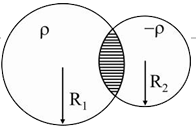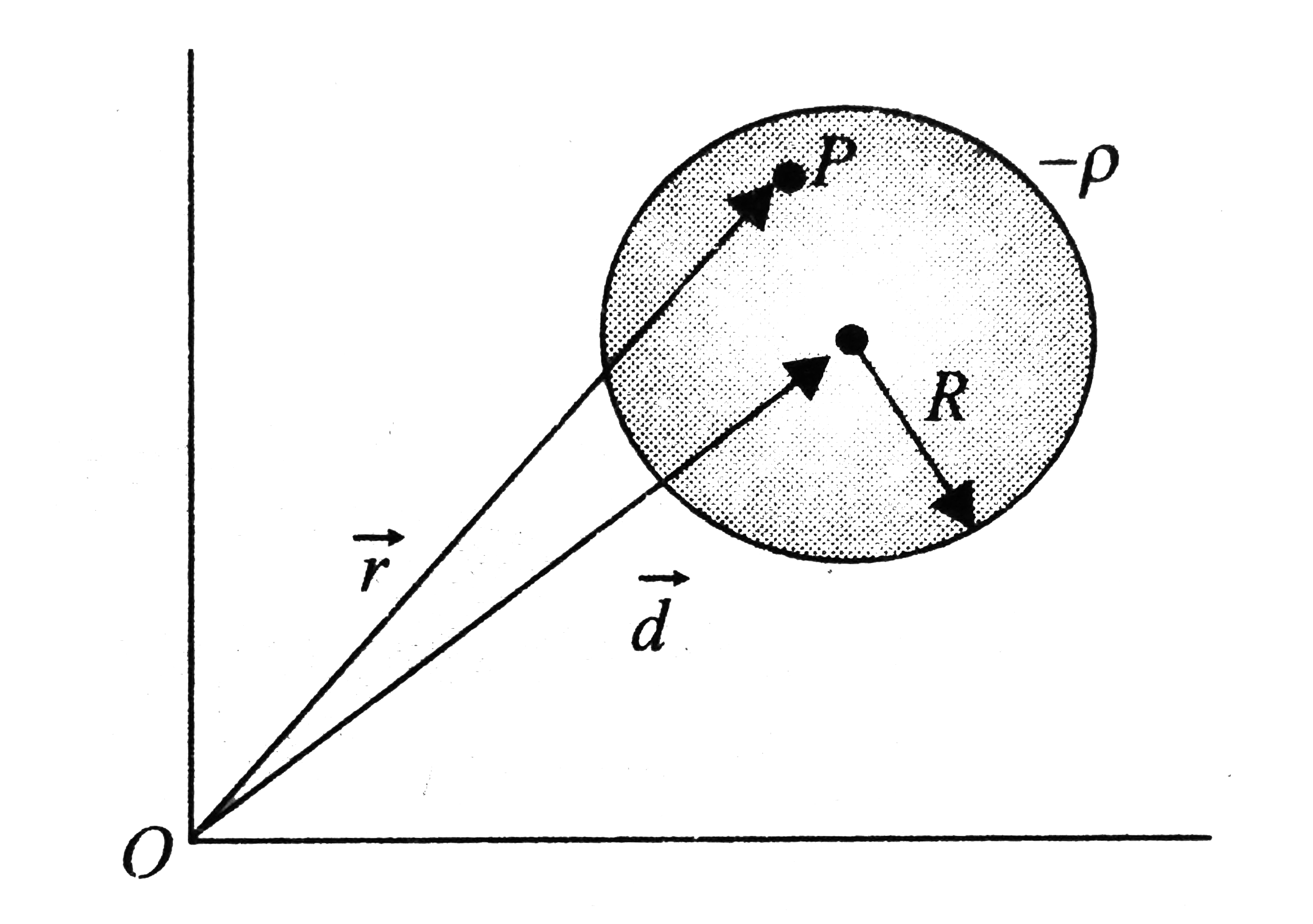Two non-conducting solid spheres of radii R and 2R, having uniform volume charge densities ρ1 and ρ2 respectively, touch each other. The net electric field at a distance 2R from the centre of the smaller sphere, along the line joining the centres of the spheres, is zero. The ratio ρ1ρ2 can be
−4
−3225
3225
4
The correct Answer is:B, D
First of all electric field intensity due to a non-conducting solid sphere of radius R with charge uniformly distributed over the volume can be written as follows:

x < R ⇒E=ρx3ε0 ..(i)
x > R ⇒E=ρR33ε0x2....(ii)
See the figure to understand the described question. There are two points on the line joining the centres of spheres, which are at a distance 2R apart from the centre of a smaller sphere. Assuming the polarities to be positive for both, we shall do a calculation and if they are of opposite polarity then the answer should indicate it. For example, let us proceed for the point P and we can see that both the fields are shown in the same direction but we require net field intensity to be zero. In the figure, E1 represents electric field intensity due to the smaller sphere and E2 represent the electric field intensity due to the bigger sphere.Point P : E1+E2=0
⇒ρ1R33ε0(2R)2+ρ2(2R)33ε0(5R)2=0
⇒ρ1ρ2=−(2)3(2)2(5)2=−3225
Option (b) is correct
Point Q:
E1−E2=0
⇒ρ1R33ε0(2R)2−ρ2(R)3ε0=0⇒ρ1ρ2=4
Topper's Solved these Questions
- BOOK - MODERN PUBLICATIONCHAPTER - ELECTRIC CHARGES AND FIELDS EXERCISE - COMPETITION FILE ( Objective Question (D.MCQ) Passage )10videos
ELECTRIC CHARGES AND FIELDS
- BOOK - MODERN PUBLICATIONCHAPTER - ELECTRIC CHARGES AND FIELDS EXERCISE - COMPETITION FILE ( Objective Question (Assertion Reason ) )15videos
ELECTRIC CHARGES AND FIELDS
- BOOK - MODERN PUBLICATIONCHAPTER - ELECTRIC CHARGES AND FIELDS EXERCISE - COMPETITION FILE ( Objective Question (BC.MCQ))10videos
ELECTRIC CHARGES AND FIELDS
- BOOK - MODERN PUBLICATIONCHAPTER - DUAL NATURE OF RADIATION AND MATTER EXERCISE - CHAPTER PRACTICE TEST15videos
DUAL NATURE OF RADIATION AND MATTER
- BOOK - MODERN PUBLICATIONCHAPTER - ELECTROMAGNETIC INDUCTIONEXERCISE - CHAPTER PRACTICE TEST FOR BOARD EXAMINATION14videos
ELECTROMAGNETIC INDUCTION
Similar Questions
Two non-conducting spheres of radii R1 and R2 and carrying uniform volume charge densities +ρ and −ρ respectively are placed such that they partially overlapping region.
 View Solution
View SolutionThere is a hemisphere of radius R having a uniform volume charge density ρ. Find the electric potential and field at the centre
View Solution
Knowledge Check
- Question 1 - Select One
An insulating solid sphere of the radius R is charged in a non - uniform manner such that the volume charge density ρ=Ar, where A is a positive constant and r is the distance from the centre. The potential difference between the centre and surface of the sphere is
AAR8ε0BAR4ε0CARε0DAR2ε0 - Question 2 - Select One
A non-conducting solid sphere of radius R is uniformly charged. The magnitude of the electric filed due to the sphere at a distance r from its centre
AIncreases as r increases inside the sphereBDecreases as r increases inside as well as outsideCIncreases as increases outside the sphereDIs discontinuousat r=R - Question 3 - Select One or More
A non-conducting solid sphere of radius R is uniformly charged. The magnitude of the electric filed due to the sphere at a distance r from its centre
A(a) increases as r increases, for r<R.B(b) decreases as r increases, for 0<r<∞.C(c) decreases as r increases, for R<r<∞.D(d) is discontinuous at r=R.
An insulating solid sphere of the radius R is charged in a non - uniform manner such that the volume charge density ρ=Ar, where A is a positive constant and r is the distance from the centre. The potential difference between the centre and surface of the sphere is
View SolutionA nonconducting sphere of radius R is filled with uniform volume charge density −ρ. The center of this sphere is displaced from the origin by →d. The electric field →E at any point P having position vector inside the sphere is
 View Solution
View SolutionTwo conducting spheres of radii r1 and r2 are charged to the same surface charge density . The ratio of electric field near their surface is
View SolutionInside a uniform sphere of density ρ there is a spherical cavity whose centre is at a distance l from the centre of the sphere. Find the strength of the gravitational field inside the cavity.
View SolutionThe electric field at 2R from the centre of a uniformly charged non - conducting sphere of rarius R is E. The electric field at a distance R2 from the centre will be
View Solution
